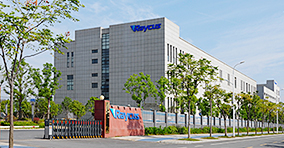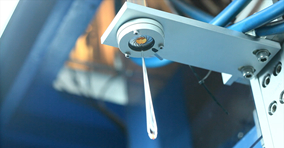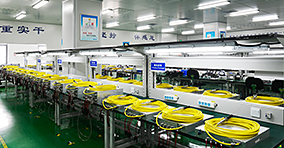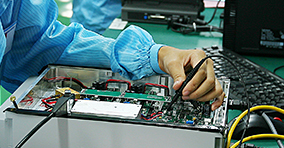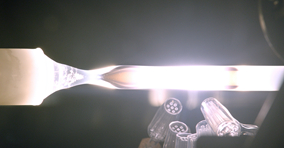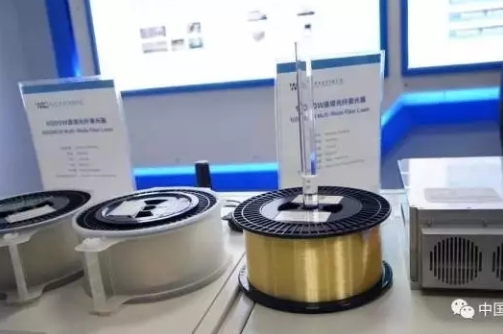Hubei Daily: Enter Stanford in Optics Valley and feel China’s “photoelectric heart”!
Huazhong University of Science and Technology is known as the “Stanford” of Optics Valley in China .
On April 25th, “Hubei Daily” focused on Wuhan Optoelectronics National Laboratory on the front page and the third edition, reporting on how Optics Valley and Huake complement each other and produce fruitful results of the integration of industrial development and scientific research and innovation!
In 2003, in order to cope with the rapid development of global optoelectronic technology and industry, Huazhong University of Science and Technology, Wuhan Institute of Physics and Mathematics, Chinese Academy of Sciences, Wuhan Institute of Posts, and China Shipbuilding Industry Seventeenth Institute jointly established Wuhan Optoelectronics National Laboratory.
This innovation hall located under Yujia Mountain is the only national laboratory in Hubei Province.
In the past 5 years, it has gathered many innovation teams, and its research and development fields involve six major optoelectronic fields: biomedical photonics, optoelectronic devices and integration, information storage and light display, energy photonics, laser and terahertz technology, and photon radiation and detection. Achieve a number of world-leading technical results, and successfully applied to industries and markets.
Come, walk into this national innovation platform and see what happens.
Dazzling Photoelectric Technology
Light becomes electricity, electricity becomes light. There are many such advanced technologies in Wuhan Optoelectronics National Laboratory.
With a set of high-tech equipment called MOST, the nerves and blood vessels in the rat’s brain can be seen at a glance.
In 2010, Luo Qingming, executive deputy director of Wuhan Optoelectronics National Laboratory and vice president of Huazhong University of Science and Technology, led the team to obtain the first high-resolution three-dimensional connection map of the mouse whole brain in the world.
Previously, the world’s research on the brain only stayed on local sections. The major breakthrough of this achievement was the first realization of high-resolution imaging of the whole brain, which can not only see the whole picture, but also every neuron or capillary.
After the series of research results were published in the top international academic journals “Science”, “Nature · Methods” and “Nature · Communications”, they attracted great attention from the brain science community at home and abroad.
The picture shows Luo Qingming (former), executive deputy director of Wuhan Optoelectronics National Laboratory, leading a team to carry out scientific and technological research in the laboratory.
(Photo by Mei Tao)
Luo Qingming introduced that MOST is also called micro-optical slice tomography system , and its working principle is similar to the use of satellites to make panoramic scans of the earth. Using optical imaging methods, mouse brain neural pathways under the microscope are like a glowing Amazon forest. Not only can you see local neural connections, but you can also observe the three-dimensional “roads” and “railways” that build neural networks in the whole brain.
A piece of ordinary conductive glass, screen printing technology, brush titanium dioxide, zirconium dioxide and black carbon electrodes in three layers, and then fill some perovskite materials, you can generate electricity at home.
“Printed solar energy” allows the sun’s light energy to be instantly converted into electricity, which is more efficient and cheaper than traditional solar energy conversion methods.
The inventor of this achievement, Professor Han Hongwei of Wuhan Optoelectronics National Laboratory, introduced that solar cells have undergone decades of development, from silicon cells and thin-film cells to the third generation of perovskite technology. Perovskite is a ceramic oxide and has a good semiconductor photoelectric effect. In terms of materials and manufacturing processes, the cost of “printed solar energy” is much lower than the use of silicon or thin film materials.
Currently, the technology is being transformed by Hubei Wandu Solar Energy Co., Ltd. in Ezhou. The company’s deputy general manager, Honor Light, calculated a bill: a solar cell with a conversion efficiency of less than 18%. Calculated with 180 watts of electricity per square meter, the cost of laying a 50-square-meter battery panel is 20,000 yuan, which is equivalent to a family’s electricity bill for 10 years, which is not cost-effective for ordinary people.
The “printed solar” solar panel of the same area can generate 25 kWh of electricity per day, and the laying cost only needs 4,000 yuan, which is 1/5 of the former cost.
Gather more than 350 photoelectric scientists
Wuhan Optoelectronics National Laboratory is positioned to seize the tide of innovation in optoelectronics and represent the country in participating in world competition.
Under the banner of “openness, mobility, alliance and competition”, more than 350 first-class talents in optoelectronics gathered here.
Here are Professor Brighton Johnson, the father of biomedical photonics, Academician Qi Yihua, winner of the Nobel Prize in Chemistry, and Professor Glanzell, father of dye-sensitized solar cells.
Here, there are 5 members of the Chinese Academy of Sciences and the Chinese Academy of Engineering, 10 experts from the National Thousand Talents Program, 5 chief scientists from 973, 21 Yangtze River scholars, and 76 overseas academic backbones.
In 2013, Yan Dapeng, a professor from Wuhan Optoelectronics National Laboratory who returned from the United States, led the team and successfully developed China’s first 10,000 watt continuous fiber laser. The laser energy released by an optical fiber with the thickness of an embroidery needle can be used to weld aircraft and ships.
10,000 watt continuous fiber laser
Last month, the 20,000-watt fiber laser made by Rui Scientific was unveiled and is actively moving towards the market.
Previously, the market price of an imported 20,000-watt fiber laser was about 6 million yuan. After domestic production, the price is expected to decrease by 40%. Compared with the traditional carbon dioxide laser, the fiber laser consumes only 1/5 of its power and 1/10 of its volume, but is 4 times faster, 20% more efficient, and free of pollution.
Professor Zeng Xiaoyan independently developed the laser selective melting forming technology and equipment, which has achieved the world’s largest 3D printing of complex precision components with the largest forming volume and the highest efficiency, and has been applied in the aerospace field.
Professor Xie Qingguo, overcomes the world-class problem of PET digitization of cutting-edge medical instrument “Positron Emission Tomography”, developed the world’s first digital small animal PET system, and the first all-digital clinical PET / CT medical equipment for life science research 2. Medical diagnosis and treatment provide more advanced technical means.
So far, the laboratory research team has published a total of 4065 papers in world-famous journals and obtained 785 invention patents.
Provide source of kinetic energy for Optics Valley
Relying on Wuhan Optoelectronics National Laboratory, Wuhan Optoelectronics Industrial Technology Research Institute and Huazhong University of Science and Technology Ezhou Industrial Technology Research Institute, two major transformation platforms have been established.
Backed by the transformation platform, one by one the laboratory results can reach the market.
The confocal endoscope developed by Professor Fu Ling of the Optoelectronics Laboratory, through the installation of high-precision “Clairvoyance” medical fiber, can make cancer cells nowhere to look.
She pointed at the real-life medical image on the computer screen and said that the optical fiber can extend the lens to multiple human organs such as the stomach, intestine, and esophagus, magnify the cells by 1000 times, and be “exposed” before it becomes cancerous. At present, the achievement has been transformed into Wuhan Jingwei Vision Technology Co., Ltd. After hearing the news, Ezhou State-owned Investment Platform Changda Asset Management Co., Ltd. invested 20 million yuan in venture capital in one breath.
The research results of Xie Changsheng, chief scientist of Wuhan Guangyi Technology Co., Ltd. and deputy director of Wuhan Optoelectronics National Laboratory, are changing the future optical storage pattern.
In the current big data centers, solid-state disks and hard disks are commonly used for data storage to store real-time “hot data” and recent “warm data”. How to do?
Xie Changsheng spent 5 years developing a large-capacity optical disc library. In a double-door refrigerator-sized cabinet, it can store 12,200 discs, and each disc has a data storage of 100G. The optical disc library comes with a robot, like an intelligent robot, which can precisely retrieve the target optical disc according to demand. 24 optical drives read at the same time, twice the speed and storage capacity of Japanese companies.
Right now, the product has entered the Donghu High-tech Zone Government Service Data Center, the National Archives, and the public security system.
Up to now, Wuhan Optoelectronics National Laboratory has hatched 90 high-tech enterprises, with a total patent conversion of 108 million yuan.


